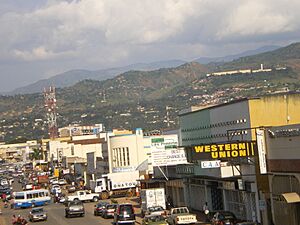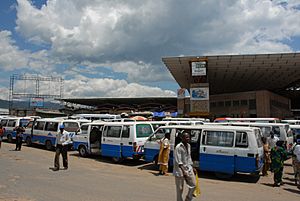Bujumbura facts for kids
Quick facts for kids
Bujumbura
|
|
|---|---|
|
Top: Bujumbura skyline; Middle: Monument to Independence Heroes, Downtown Bujumbura; Regina Mundi Cathedral, Beach at Lake Tanganyika
|
|
| Nickname(s): | |
| Country | |
| Province | Bujumbura Mairie Province |
| Founded | 1871 |
| Area | |
| • Urban | 127 km2 (49 sq mi) |
| Elevation | 774 m (2,539 ft) |
| Population
(2023)
|
|
| • City | 374,809 |
| • Urban | 1,143,202 |
| • Urban density | 9,000/km2 (23,310/sq mi) |
| Time zone | UTC+2 (CAT) |
| Climate | Aw |
Bujumbura was once known as Usumbura. It is the largest city and main port of Burundi. It is also the country's economic capital. Bujumbura ships most of Burundi's main exports. These include coffee, cotton, and tin ore.
Bujumbura used to be Burundi's political capital. In December 2018, the president of Burundi, Pierre Nkurunziza, announced a plan. He wanted to move the political capital back to Gitega. Bujumbura would remain the economic and business center. The Parliament of Burundi made this change official on January 16, 2019. Government offices moved to Gitega over the next three years.
Contents
History of Bujumbura
Bujumbura started as a small village. It became a military post in German East Africa in 1889. After World War I, it became the main administrative center. This was for the Belgian League of Nations area called Ruanda-Urundi.
The city's name changed from Usumbura to Bujumbura in 1962. This happened when Burundi became an independent country. After independence, Bujumbura saw periods of conflict. These involved different groups within the country.
Geography and Climate
Bujumbura is located on the north-eastern shore of Lake Tanganyika. This lake is the second deepest lake in the world. Only Lake Baikal is deeper. The city is also where several rivers meet the lake. These include the Ruzizi River and smaller rivers like the Mutimbuzi, Ntahangwa, Muha, and Kanyosha River.
Bujumbura's Climate
Bujumbura has a tropical savanna climate. This means it has clear wet and dry seasons. The wet season lasts from October to April. The city is close to the equator. Because of this, temperatures do not change much throughout the year. The average high temperature is around 29°C (84°F). The average low is about 19°C (66°F).
City Administration
Bujumbura is managed by a community council and an administrator. The city is divided into three main areas called communes. Each commune has its own council and leader.
These three communes were created in 2014. They replaced 13 older communes. The current communes are:
- Commune of Muha
- Commune of Mukaza
- Commune of Ntahangwa
Economy and Trade
The Port of Bujumbura is the biggest port on Lake Tanganyika. Burundi relies on nearby countries to reach the ocean for trade. Goods can travel by road through Rwanda. They can also go by lake and then by road or train through Tanzania, Congo, or Zambia.
Most of Burundi's international trade, about 80%, uses these routes. The Port of Bujumbura handles all these goods. It manages both imports (goods coming in) and exports (goods going out). In 2011, over 90% of the goods handled were imports. About 60% of these imports arrived by ship. The other 40% came by truck.
The Bujumbura Central Market was once a very busy place. It was located in the city center. In January 2013, a large fire destroyed the central market. This caused a big problem for local businesses. Many vendors lost their goods.
Sports and Recreation
Bujumbura is home to the Intwari stadium. This is a large sports stadium. It is mainly used for football matches. It is the biggest stadium in Burundi, with 22,000 seats.
The city also has many courts for basketball and tennis. You can find many indoor and outdoor swimming pools too.
Education in Bujumbura
Bujumbura has several universities. The main one is the University of Burundi. Other universities include Hope Africa University and Université du Lac Tanganyika.
There are also international schools in Bujumbura. These schools offer different teaching styles. Some examples are:
- École Belge de Bujumbura (Belgian school)
- École Française de Bujumbura (French school)
- King's School (British school)
- Bujumbura International Montessori School
- Burundi English School
Transportation in the City
The Bujumbura International Airport is just outside the city. It helps people travel to and from Bujumbura by air.
Public transport in Bujumbura mostly uses taxis and mini-buses. These mini-buses are known as Hiace. They are usually white and blue. Taxis are common and are considered a safe way to get around. You can also find taxi-motos (motorcycle taxis) and taxis-vélos (bicycle taxis) in some areas.
For longer trips, many people use the Hiace vans. These vans travel regularly across Burundi. Bujumbura's main bus station is located near the Central Market.
Health Services
Bujumbura has many clinics and major hospitals. These include the Prince Regent Charles Hospital, the Roi Khaled Hospital, and Kamenge Military Hospital. These facilities provide important health care for the city and province.
Places of Worship
Bujumbura has many places of worship. Most of these are Christian churches. Examples include the Roman Catholic Archdiocese of Bujumbura and churches from the Anglican Communion. There are also Muslim mosques in the city.
Culture and Attractions
Bujumbura offers many interesting places to visit. These include museums, parks, and monuments. The Burundi Museum of Life and the Burundi Geological Museum are in the city.
Other nearby attractions are:
- The Rusizi National Park
- The Livingstone-Stanley Monument at Mugere. This is where explorers David Livingstone and Henry Morton Stanley visited.
- The presidential palace.
- The source of the southernmost tributary of the Nile. This is locally known as the source of the Nile River.
Bujumbura was also home to Imagine Burundi. This was a weekly radio show. It was the first English-language program made locally. It shared stories about life in the region. The show aired from September 2010 to August 2013.
City Growth
Bujumbura is expected to be one of the fastest-growing cities in Africa. Between 2020 and 2025, it was projected to grow by about 5.75%.
Sister Cities
Bujumbura is connected with other cities around the world. These are called sister cities.
 Ubon Ratchathani, Thailand
Ubon Ratchathani, Thailand Corigliano Calabro, Italy
Corigliano Calabro, Italy
Notable People
- Jeanne Gapiya-Niyonzima, an activist
Images for kids
See also
 In Spanish: Buyumbura para niños
In Spanish: Buyumbura para niños














